 W
WThe visual arts are art forms such as painting, drawing, printmaking, sculpture, ceramics, photography, video, filmmaking, design, crafts and architecture. Many artistic disciplines such as performing arts, conceptual art, and textile arts also involve aspects of visual arts as well as arts of other types. Also included within the visual arts are the applied arts such as industrial design, graphic design, fashion design, interior design and decorative art.
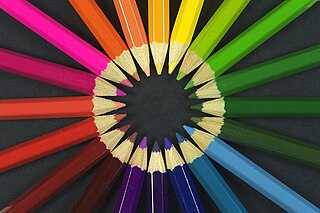 W
WThe following outline is provided as an overview of and topical guide to the visual arts:
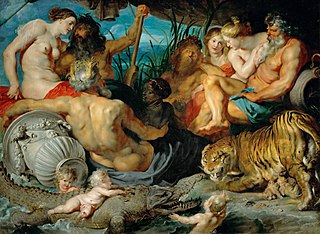 W
WA work of art, artwork, art piece, piece of art or art object is an artistic creation of aesthetic value. Except for "work of art", which may be used of any work regarded as art in its widest sense, including works from literature and music, these terms apply principally to tangible, physical forms of visual art:An example of fine art, such as a painting or sculpture. An object that has been designed specifically for its aesthetic appeal, such as a piece of jewellery. An object that has been designed for aesthetic appeal as well as functional purpose, as in interior design and much folk art. An object created for principally or entirely functional, religious or other non-aesthetic reasons which has come to be appreciated as art. A non-ephemeral photograph, film or visual computer program, such as a video game or computer animation A work of installation art or conceptual art.
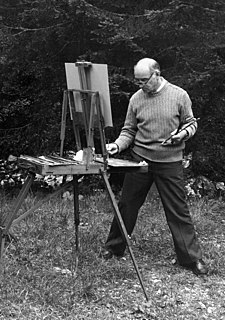 W
WAbstract Impressionism is an art movement that originated in New York City, in the 1940s. It involves the painting of a subject such as real-life scenes, objects, or people (portraits) in an Impressionist-style, but with an emphasis on varying measures of abstraction. The paintings are often painted en plein air, an artistic style involving painting outside with the landscape directly in front of the artist. The movement works delicately between the lines of pure abstraction and the allowance of an impression of reality in the painting.
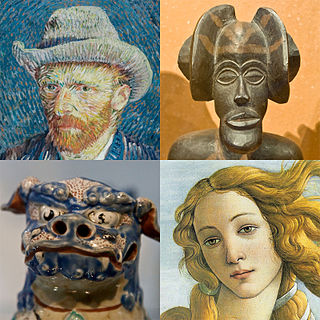 W
WArt is a diverse range of human activities involving the conscious use of creative imagination to express technical proficiency, beauty, emotional power, or conceptual ideas.
 W
WAn art colony, also known as an artists' colony, can be defined two ways. Its most liberal description refers to the organic congregation of artists in towns, villages and rural areas, often drawn by areas natural beauty, the prior existence of other artists or art schools there, and a lower cost of living. More commonly, the term refers to the guest-host model of a mission-driven planned community, which administers a formal process for awarding artist residencies. In the latter case, a typical mission might include providing artists with the time, space and support to create; fostering community among artists; and providing arts education to the public. Early 20th century American guest-host models include New Hampshire's MacDowell Colony and New York's Yaddo.
 W
WAn art film is typically an independent film, aimed at a niche market rather than a mass market audience. It is "intended to be a serious, artistic work, often experimental and not designed for mass appeal", "made primarily for aesthetic reasons rather than commercial profit", and contains "unconventional or highly symbolic content".
 W
WAuthenticity in art is manifest in the different ways that a work of art, or an artistic performance, can be considered authentic. The initial distinction is between nominal authenticity and expressive authenticity. In the first sense, nominal authenticity is the correct identification of the author of a work of art; of how closely an actor or an actress interprets a role in a stageplay as written by the playwright; of how well a musician’s performance of an artistic composition corresponds to the composer’s intention; and how closely an objet d’art conforms to the artistic traditions of its genre. In the second sense, expressive authenticity is how much the work of art possesses inherent authority of and about its subject, and how much of the artist’s intent is in the work of art.
 W
WClimate change art is art inspired by climate change and global warming, generally intended to overcome humans' hardwired tendency to value personal experience over data and to disengage from data-based representations by making the data "vivid and accessible". The intention is to "make an emotional connection...through the power of art".
 W
WEdible art refers to food created to be art. It is distinguished from Edible Arrangements because it is usually more elaborate dessert food. A common form of edible art is wedding cakes, but options for artistic confections range far beyond marital celebrations. Cakes made into art include birthday cakes, cakes for baby showers, for graduation celebrations, and many other types of event. Each piece looks unique, even if created for the same event, because each creator has their own idea in mind when creating their food art. Such pieces of art can be created using a cake base onto which the decorations are placed on, or they can be made purely out of fondant or sugar, while edible, is not created with consumption intended, such as Mexican Calavera
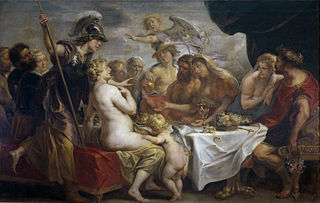 W
WA figure painting is a work of fine art in any of the painting media with the primary subject being the human figure, whether clothed or nude. Figure painting may also refer to the activity of creating such a work. The human figure has been one of the constant subjects of art since the first stone age cave paintings, and has been reinterpreted in various styles throughout history.
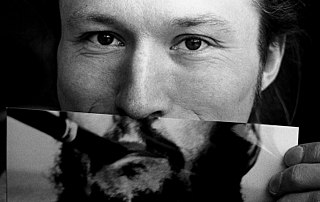 W
WAlexander Gnylytsky was a Ukrainian artist who was one of the pioneers of the New Ukrainian Wave. In 1994 he became a member of the Kiev art group named "Paris Commune". From 1996 he was one of the founders and the head of the Institute of Unstable Thoughts. He worked on installation and video art and represented Ukraine at the Venice Biennale in 2007. Much of his work resonates with the Italian transavantgarde movement.
 W
WA handicraft, sometimes more precisely expressed as artisanal handicraft or handmade, is any of a wide variety of types of work where useful and decorative objects are made completely by one’s hand or by using only simple, non-tech related tools like scissors, carving implements, or hooks. It is a traditional main sector of craft making and applies to a wide range of creative and design activities that are related to making things with one's hands and skill, including work with textiles, moldable and rigid materials, paper, plant fibers, etc. One of the oldest handicraft is Dhokra; this is a sort of metal casting that has been used in India for over 4,000 years and is still used. In Iranian Baluchistan, women still make red ware hand made pottery with dotted ornaments much similar to the 5000 year old pottery tradition of Kalpurgan, an archaeological site near the village. Usually, the term is applied to traditional techniques of creating items that are both practical and aesthetic. Handicraft industries are those that produce things with hands to meet the needs of the people in their locality without using machines.
 W
WMacramé is a form of textile produced using knotting techniques.
 W
WMasterpiece, magnum opus or chef-d’œuvre in modern use is a creation that has been given much critical praise, especially one that is considered the greatest work of a person's career or to a work of outstanding creativity, skill, profundity, or workmanship. Historically, a "masterpiece" was a work of a very high standard produced to obtain membership of a guild or academy in various areas of the visual arts and crafts.
 W
WMathematics and art are related in a variety of ways. Mathematics has itself been described as an art motivated by beauty. Mathematics can be discerned in arts such as music, dance, painting, architecture, sculpture, and textiles. This article focuses, however, on mathematics in the visual arts.
 W
WMuscleman may denote any man with well-developed muscles, in particular a bodybuilder. In art-related and anatomical contexts, the term is also used for a model in wax showing the muscles of a man. Such a figure showing the muscles of the human body without skin is also called écorché.
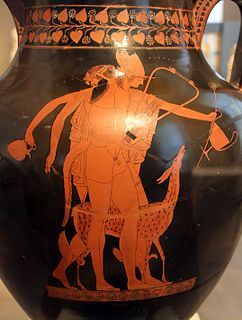 W
WIn art history, a namepiece is an artwork after which an otherwise unnamed artist is named. There is a long history of giving notnames to artists whose identity has been lost.
 W
WThe nude, as a form of visual art that focuses on the unclothed human figure, is an enduring tradition in Western art. It was a preoccupation of Ancient Greek art, and after a semi-dormant period in the Middle Ages returned to a central position with the Renaissance. Unclothed figures often also play a part in other types of art, such as history painting, including allegorical and religious art, portraiture, or the decorative arts.
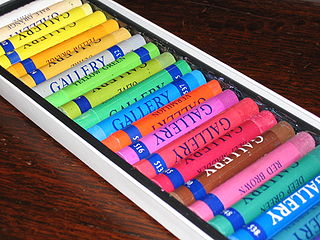 W
WAn oil pastel is a painting and drawing medium formed into a stick which consists of pigment mixed with a binder mixture of non-drying oil and wax, in contrast to other pastel sticks which are made with a gum or methyl cellulose binder, and in contrast to wax crayons which are made without oil. The surface of an oil pastel painting is less powdery than one made from gum pastels, but more difficult to protect with a fixative.
 W
WA pastel is an art medium in the form of a stick, consisting of powdered pigment and a binder. The pigments used in pastels are similar to those used to produce some other colored visual arts media, such as oil paints; the binder is of a neutral hue and low saturation. The color effect of pastels is closer to the natural dry pigments than that of any other process. Pastels have been used by artists since the Renaissance, and gained considerable popularity in the 18th century, when a number of notable artists made pastel their primary medium.
 W
WA photo stand-in is a large board with an image printed on it and that has one or more holes cut out where people can stick their face through the board for humorous effect. The hole aligns with an area in the image that creates an optical illusion of the person's face being an actual part of the scene. This illusion is then often immortalized by taking a photograph of the person's face through the board. Photo stand-ins may be found at midways, carnivals, parties, tourist traps, theme parks and similar locations and events that people visit for entertainment. The television game show You're in the Picture revolved around celebrity guests using a photo stand-in, having to guess what scene they were in.
 W
WPortals is a global public art initiative that connects people around the globe through real-time video audiovisual technology housed inside a gold-painted, converted shipping container or other structure. Individuals and groups enter local Portals and engage with individuals or groups in distant Portals through live, full-body video conferencing. The experience has been described as "breathing the same air." Portals are placed in public spaces such as public squares, museums, university campuses, high-level summits, and refugee camps. Participation is free, and the spaces are maintained by staff called Portal_Curators.
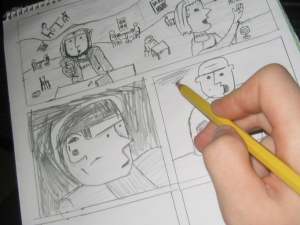 W
WIn comics studies, sequential art is a term proposed by comics artist Will Eisner to describe art forms that use images deployed in a specific order for the purpose of graphic storytelling or conveying information. The best-known example of sequential art is comics.
 W
WA snow globe is a transparent sphere, traditionally made of glass, enclosing a miniaturized scene of some sort, often together with a model of a town, landscape or figure. The sphere also encloses the water in the globe; the water serves as the medium through which the "snow" falls. To activate the snow, the globe is shaken to churn up the white particles. The globe is then placed back in its position and the flakes fall down slowly through the water. Snow globes sometimes have a built-in music box that plays a song. Some snow globes have a design around the outerbase for decoration. Snow globes are often used as a collectible item.
 W
WThe sociology of art is a subfield of sociology concerned with the social worlds of art and aesthetics.
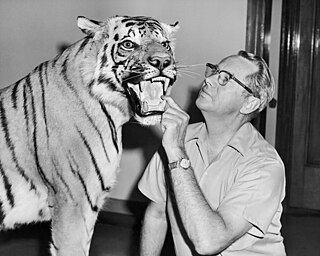 W
WTaxidermy is the art of preserving an animal's body via mounting or stuffing, for the purpose of display or study. Animals are often, but not always, portrayed in a lifelike state. The word taxidermy describes the process of preserving the animal, but the word is also used to describe the end product, which are called taxidermy mounts or referred to simply as "taxidermy".
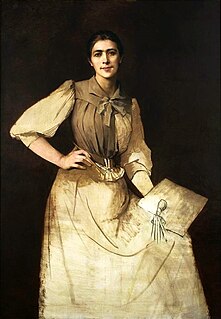 W
WUnderdrawing is a preparatory drawing done on a painting ground before paint is applied, for example, an imprimatura or an underpainting. Underdrawing was used extensively by 15th century painters like Jan van Eyck and Rogier van der Weyden. These artists "underdrew" with a brush, using hatching strokes for shading, using water-based black paint, before underpainting and overpainting with oils. Cennino D'Andrea Cennini describes a different type of underdrawing, made with graded tones rather than hatching, for egg tempera.
 W
WThe vagina and vulva have been depicted in art from prehistory to the contemporary art era of the 21st century. Visual art forms representing the female genitals encompass two-dimensional and three-dimensional. As long ago as 35,000 years ago, people sculpted Venus figurines that exaggerated the abdomen, hips, breasts, thighs, or vulva.
 W
WFrank Wimberley is an African American abstract expressionist artist.